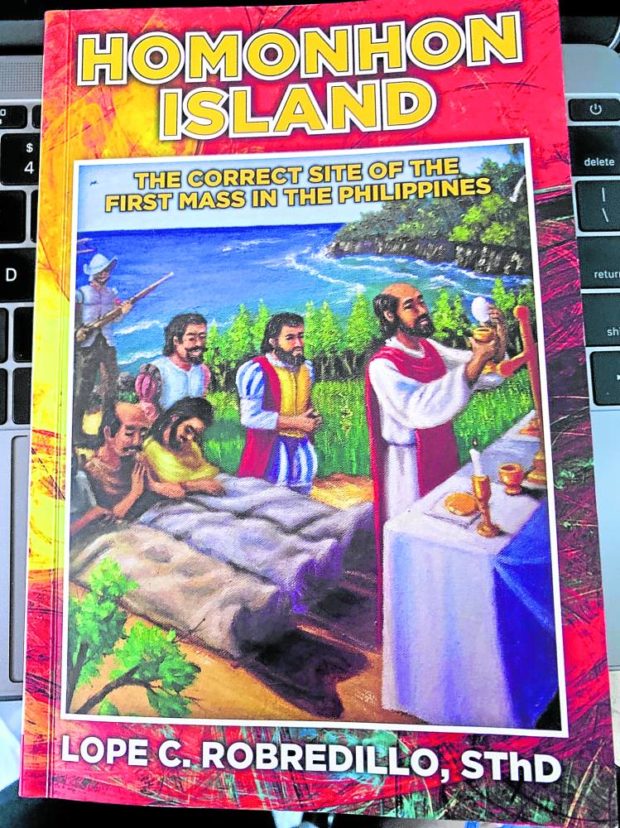Priest’s book keeps debate on first PH Mass site alive

NO FINAL WORD | The 2021 book by Msgr. Lope Robredillo refuses to put the historical question to rest.
GUIUAN, Eastern Samar, Philippines — Even after decades of heated discussions, including those connected to last year’s commemoration of the 500th year since the arrival of Christianity in the Philippines, the debate as to where the first Easter Mass was held in the country continues.
For Msgr. Lope Robredillo, vicar general of the Diocese of Borongan and one of the chaplains newly installed by Pope Francis, one thing is clear: the first Roman Catholic Mass was celebrated in Homonhon island off Guiuan in Eastern Samar.
Robredillo contended in his 240-page book, “Homonhon Island: The Correct Site of the First Mass in the Philippines,” that Fr. Pedro de Valderrama, Ferdinand Magellan’s chaplain in the Armada de Maluco, officiated the first Holy Mass on the island on March 17, 1521.
“It is my contention that the first Mass was officiated in Homonhon. For one thing, it is clear in the account of Antonio Pigafetta that the Mass in Mazzaua [Limasawa in Southern Leyte] was not the first Mass, for nowhere does his account refer to it as such,” he said.
Indeed, what has been officially declared by the National Historical Commission of the Philippines is that the first Easter Mass was celebrated in Limasawa on March 13, 1521.
Article continues after this advertisement“The first one to call the Mazzaua Mass was Fr. Francisco Colin who was neither a witness to the event nor a part of the Magellan expedition. In addition, that the National Historical Commission circumscribed the issue to the first Easter Mass is a tacit admission that a Mass could have been celebrated before that. And indeed, there was—in Homonhon,” Robredillo said.
Article continues after this advertisementFresh arguments
With the aid of rare and old books, including Magellan’s reconstructed diary, related to the Magellan-Elcano circumnavigation of the world, read in the light of a sociological-theological approach to history, and exceeding the “no document, no history” mantra, Robredillo’s work published in 2021 offers fresh arguments that had not been properly presented before.
Robredillo, however, said that a number of writers had already proposed that the first Mass took place in Homonhon.
Among those who hold this opinion are Jose Vicente Braganza, a priest of the Society of the Divine Word (SVD) and historian Danilo Gerona.
Both claimed that it was only natural that after a long and treacherous voyage, Magellan and his crew would offer a thanksgiving Mass as soon as they found land.
Robredillo also cited Cantius Kabak, a Polish priest who asserted that even if Pigafetta made no mention of public acts of worship, such an event could not be ruled out.
Great feast days like Holy Week could not have been neglected.
Also cited was local historian Tomas Gomez III, former Press Secretary of the late president Corazon Aquino, who argued that since Pigafetta only wrote about five instances when Masses were said from 1519 to 1522, it would be preposterous to conclude that no other Masses were said.
‘Interpreted history’
Masses are celebrated every Sunday, even if Pigafetta did not enter them in his journal.
When the last review of the claims of both Limasawa and Butuan to being the site of the first mass was requested in 2018, NHCP chair Rene Escalante, who also chaired the Philippine Quincentennial Committee, changed the issue from “First Mass” to “1521 First Easter Mass,” which Robredillo believes is an acknowledgement that the Easter Mass in Mazzaua was not the first Mass.
Robredillo argued in his book that history could not be based solely on written documents but must also take into account the socio-theological perspective to determine whether events took place—or did not.
“History is always an interpreted history. In the absence of a written document, one can, with proper methodology, arrive at the certainty of an event with the aid of circumstantial evidence and related disciplines in history,” he said.
The practice of daily celebration of the Mass and centrality of the Eucharist in the Middle ages highlight this contention. Considering that religious observances were an integral part of the daily routine in ships, and that the Church consistently insisted on the participation on Sunday Eucharist, there could not be any doubt that Mass was celebrated in Homonhon, definitely on March 17, Sunday of the Passion of the Lord, then on March 19, feast of St. Joseph, March 24 Palm Sunday, and March 25, feast of the Annunciation of the Blessed Virgin Mary, Robredillo pointed out.
Contrary to practice
Celebrating the “first mass” 14 days after landing in the archipelago was contrary to the common practice of thanking God immediately, especially after all the difficulties that the expedition went through.
As to Pigafetta’s failure to chronicle the Masses in Homonhon, Robredillo said that every historian was selective in his data.
His focus was not on documenting the Masses, as these would have been an ordinary part of their routine, so ordinary like their daily meals and their nightly rest that they would not have merited a paragraph or two.
It may have taken more than 500 years, but Robredillo said to recognize Homonhon island in Eastern Samar as the setting of Christ’s first Eucharistic presence is still an honor and a gratifying departure from the violence and frequent typhoons that have come to be associated with the province.
RELATED STORIES
Limasawa, not Butuan, affirmed as site of first Mass in PH